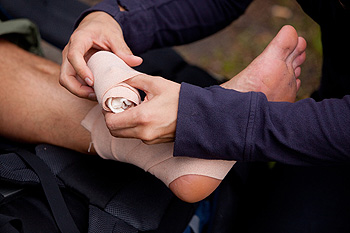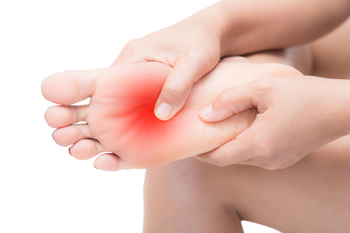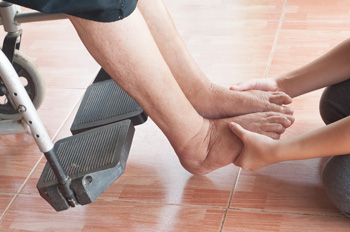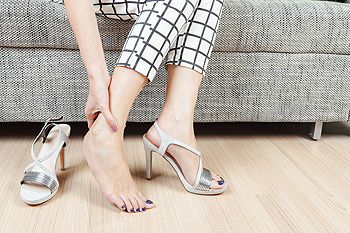Blog
Why You Should See a Podiatrist for an Ankle Sprain
 Ankle sprains occur when the ligaments which connect the bones in the ankle become overstretched or even torn. This is often a result of the ankle being twisted. Ankle sprains can range from mild, where the ankle is tender and swollen, to severe, where the ankle is unstable and unable to bear weight. Ankle sprains should be treated by a podiatrist because recurring or severe sprains can result in long term weakness and joint pain in the ankle. Depending on the severity of the sprain, a podiatrist may take X-rays of the ankle to make sure there are no broken bones. A podiatrist will also be able to guide the recovery and rehabilitation of the ankle sprain.
Ankle sprains occur when the ligaments which connect the bones in the ankle become overstretched or even torn. This is often a result of the ankle being twisted. Ankle sprains can range from mild, where the ankle is tender and swollen, to severe, where the ankle is unstable and unable to bear weight. Ankle sprains should be treated by a podiatrist because recurring or severe sprains can result in long term weakness and joint pain in the ankle. Depending on the severity of the sprain, a podiatrist may take X-rays of the ankle to make sure there are no broken bones. A podiatrist will also be able to guide the recovery and rehabilitation of the ankle sprain.
Although ankle sprains are common, they aren’t always minor injuries. If you need your ankle injury looked at, contact Elliot T. Udell, DPM from New York. Our doctor can provide the care you need to keep you pain-free and on your feet.
How Does an Ankle Sprain Occur?
Ankle sprains are the result of a tear in the ligaments within the ankle. These injuries may happen when you make a rapid shifting movement while your foot is planted. A less common way to sprain your ankle is when your ankle rolls inward while your foot turns outward.
What Are the Symptoms?
- Pain at the sight of the tear
- Bruising/Swelling
- Ankle area is tender to touch
- In severe cases, may hear/feel something tear
- Skin discoloration
Preventing a Sprain
- Wearing appropriate shoes for the occasion
- Stretching before exercises and sports
- Knowing your limits
Treatment of a Sprain
In many cases, the RICE method (Rest, Ice, Compression, and Elevate) is used to treat ankle sprains. However, you should see a podiatrist to see which treatment option would work best with your injury. In severe cases, surgery may be required.
It is important to ask your doctor about rehab options after you receive treatment for your injury. Stretching, strength training, and balance exercises may help the ankle heal while also preventing further injury.
If you have any questions, please feel free to contact our office located in Hicksville, NY . We offer the newest diagnostic and treatment technologies for all your foot care needs.
Common Types of Fractures on the Outside of the Foot
The fifth metatarsal bone—the long bone connected to the little toe on the outside of the foot—is prone to breaks, with the two most common being Avulsion fractures and Jones fractures. Avulsion fractures usually occur from an injury that causes tendons or ligaments to pull a portion of the bone away from itself. A Jones fracture is less common, occurs either over time or suddenly, is harder to treat, and takes longer to heal due to less blood flow to the area. People suffering from either type of fifth metatarsal fracture can experience bruising or discomfort along the outside of the foot including tenderness, swelling, and pain. Some may even have difficulty walking. A podiatrist can properly diagnose the type of break and use several types of therapies and procedures to facilitate healing.
A broken foot requires immediate medical attention and treatment. If you need your feet checked, contact Elliot T. Udell, DPM from New York. Our doctor can provide the care you need to keep you pain-free and on your feet.
Broken Foot Causes, Symptoms, and Treatment
A broken foot is caused by one of the bones in the foot typically breaking when bended, crushed, or stretched beyond its natural capabilities. Usually the location of the fracture indicates how the break occurred, whether it was through an object, fall, or any other type of injury.
Common Symptoms of Broken Feet:
- Bruising
- Pain
- Redness
- Swelling
- Blue in color
- Numbness
- Cold
- Misshapen
- Cuts
- Deformities
Those that suspect they have a broken foot shoot seek urgent medical attention where a medical professional could diagnose the severity.
Treatment for broken bones varies depending on the cause, severity and location. Some will require the use of splints, casts or crutches while others could even involve surgery to repair the broken bones. Personal care includes the use of ice and keeping the foot stabilized and elevated.
If you have any questions please feel free to contact our office located in Hicksville, NY . We offer the newest diagnostic and treatment technologies for all your foot and ankle needs.
Why Does My Heel Hurt?
 The heel is a fatty cushion on the back of the foot that provides padding. Obesity, improperly fitting shoes, injuries and running and jumping on hard surfaces can all lead to heel pain issues. One of the most common causes of heel pain is plantar fasciitis. Plantar fasciitis occurs when the plantar fascia, the band of tissue along the bottom of the foot that connects the heel to the toes, becomes inflamed. Plantar fasciitis is often associated with a heel spur as well. When the plantar fascia tears near the heel, it can bleed and then calcify. These calcium deposits form heel spurs, which can only be detected through an X-ray. If you are struggling with heel pain, please consult with a podiatrist for a proper diagnosis and treatment.
The heel is a fatty cushion on the back of the foot that provides padding. Obesity, improperly fitting shoes, injuries and running and jumping on hard surfaces can all lead to heel pain issues. One of the most common causes of heel pain is plantar fasciitis. Plantar fasciitis occurs when the plantar fascia, the band of tissue along the bottom of the foot that connects the heel to the toes, becomes inflamed. Plantar fasciitis is often associated with a heel spur as well. When the plantar fascia tears near the heel, it can bleed and then calcify. These calcium deposits form heel spurs, which can only be detected through an X-ray. If you are struggling with heel pain, please consult with a podiatrist for a proper diagnosis and treatment.
Many people suffer from bouts of heel pain. For more information, contact Elliot T. Udell, DPM of New York. Our doctor can provide the care you need to keep you pain-free and on your feet.
Causes of Heel Pain
Heel pain is often associated with plantar fasciitis. The plantar fascia is a band of tissues that extends along the bottom of the foot. A rip or tear in this ligament can cause inflammation of the tissue.
Achilles tendonitis is another cause of heel pain. Inflammation of the Achilles tendon will cause pain from fractures and muscle tearing. Lack of flexibility is also another symptom.
Heel spurs are another cause of pain. When the tissues of the plantar fascia undergo a great deal of stress, it can lead to ligament separation from the heel bone, causing heel spurs.
Why Might Heel Pain Occur?
- Wearing ill-fitting shoes
- Wearing non-supportive shoes
- Weight change
- Excessive running
Treatments
Heel pain should be treated as soon as possible for immediate results. Keeping your feet in a stress-free environment will help. If you suffer from Achilles tendonitis or plantar fasciitis, applying ice will reduce the swelling. Stretching before an exercise like running will help the muscles. Using all these tips will help make heel pain a condition of the past.
If you have any questions please contact our office located in Hicksville, NY . We offer the newest diagnostic and treatment technologies for all your foot and ankle needs.
Peripheral Neuropathy 101
 Peripheral neuropathy is caused when the nerves in the extremities such as the hands or feet are damaged. Neuropathy is generally indicated by pain, numbness, tingling, or a pins and needles sensation in the feet. While one of the most common causes of peripheral neuropathy is diabetes, it can also be caused by metabolic disorders, alcohol, trauma, vitamin deficiency, and even genetics. Treatment options for neuropathy are often individualized and focused on the cause of the neuropathy. Therefore, patients who are experiencing the signs of peripheral neuropathy in their feet should visit a podiatrist for a proper diagnosis and treatment method.
Peripheral neuropathy is caused when the nerves in the extremities such as the hands or feet are damaged. Neuropathy is generally indicated by pain, numbness, tingling, or a pins and needles sensation in the feet. While one of the most common causes of peripheral neuropathy is diabetes, it can also be caused by metabolic disorders, alcohol, trauma, vitamin deficiency, and even genetics. Treatment options for neuropathy are often individualized and focused on the cause of the neuropathy. Therefore, patients who are experiencing the signs of peripheral neuropathy in their feet should visit a podiatrist for a proper diagnosis and treatment method.
Neuropathy
Neuropathy can be a potentially serious condition, especially if it is left undiagnosed. If you have any concerns that you may be experiencing nerve loss in your feet, consult with Elliot T. Udell, DPM from New York. Our doctor will assess your condition and provide you with quality foot and ankle treatment for neuropathy.
What Is Neuropathy?
Neuropathy is a condition that leads to damage to the nerves in the body. Peripheral neuropathy, or neuropathy that affects your peripheral nervous system, usually occurs in the feet. Neuropathy can be triggered by a number of different causes. Such causes include diabetes, infections, cancers, disorders, and toxic substances.
Symptoms of Neuropathy Include:
- Numbness
- Sensation loss
- Prickling and tingling sensations
- Throbbing, freezing, burning pains
- Muscle weakness
Those with diabetes are at serious risk due to being unable to feel an ulcer on their feet. Diabetics usually also suffer from poor blood circulation. This can lead to the wound not healing, infections occurring, and the limb may have to be amputated.
Treatment
To treat neuropathy in the foot, podiatrists will first diagnose the cause of the neuropathy. Figuring out the underlying cause of the neuropathy will allow the podiatrist to prescribe the best treatment, whether it be caused by diabetes, toxic substance exposure, infection, etc. If the nerve has not died, then it’s possible that sensation may be able to return to the foot.
Pain medication may be issued for pain. Electrical nerve stimulation can be used to stimulate nerves. If the neuropathy is caused from pressure on the nerves, then surgery may be necessary.
If you have any questions, please feel free to contact our office located in Hicksville, NY . We offer the newest diagnostic and treatment technologies for all your foot care needs.
How to Choose Shoes for Your Toddler
 There are plenty of factors to consider when buying shoes for your toddler. These include the shape of the shoes, their fastenings, flexibility, and the materials they are made of. Shoes for a toddler should be the shape of their foot, and flexible enough to provide adequate support and cushioning. They should also be made of soft, breathable materials. The fastenings on the shoes should be adjustable to help get the proper fit. As toddler’s feet grow very quickly, it is important to have their feet measured prior to trying on and buying new shoes. You should avoid buying shoes for the child to “grow into,” as wearing the wrong shoe size can lead to discomfort and injury. For more information about how to find the right shoes for your toddler, please consult with a podiatrist.
There are plenty of factors to consider when buying shoes for your toddler. These include the shape of the shoes, their fastenings, flexibility, and the materials they are made of. Shoes for a toddler should be the shape of their foot, and flexible enough to provide adequate support and cushioning. They should also be made of soft, breathable materials. The fastenings on the shoes should be adjustable to help get the proper fit. As toddler’s feet grow very quickly, it is important to have their feet measured prior to trying on and buying new shoes. You should avoid buying shoes for the child to “grow into,” as wearing the wrong shoe size can lead to discomfort and injury. For more information about how to find the right shoes for your toddler, please consult with a podiatrist.
Making sure that your children maintain good foot health is very important as they grow. If you have any questions, contact Elliot T. Udell, DPM of New York. Our doctor can provide the care you need to keep you pain-free and on your feet.
Keeping Children's Feet Healthy
Having healthy feet during childhood can help prevent medical problems later in life, namely in the back and legs. As children grow, their feet require different types of care. Here are some things to consider...
Although babies do not walk yet, it is still very important to take care of their feet.
Avoid putting tight shoes or socks on his or her feet.
Allow the baby to stretch and kick his or her feet to feel comfortable.
As a toddler, kids are now on the move and begin to develop differently. At this age, toddlers are getting a feel for walking, so don’t be alarmed if your toddler is unsteady or ‘walks funny’.
As your child gets older, it is important to teach them how to take care of their feet.
Show them proper hygiene to prevent infections such as fungus.
Be watchful for any pain or injury.
Have all injuries checked by a doctor as soon as possible.
Comfortable, protective shoes should always be worn, especially at play.
If you have any questions please feel free to contact our office located in Hicksville, NY . We offer the newest diagnostic and treatment technologies for all your foot and ankle needs.
It's Time for Beautiful Feet
How Uric Acid Causes Gout
 Gout occurs when an over-abundance of uric acid in the body creates urate crystals in a joint, causing severe pain, redness, and inflammation. The body produces uric acid as a waste product from breaking down purines—a chemical compound in certain foods and drinks. Obesity, kidney disease, water pills, cancer, and consuming too many sugary drinks, seafood, or red meat can cultivate a profusion of uric acid in the bloodstream. Left untreated, gout may cause permanent joint damage or disfigurement, and surgery may be necessary to remove hard nodules, called tophi, that can form under the skin. Since gout is a type of arthritis that can often form in the big toe or ankle, consult a podiatrist if you exhibit symptoms in order to be properly diagnosed and treated.
Gout occurs when an over-abundance of uric acid in the body creates urate crystals in a joint, causing severe pain, redness, and inflammation. The body produces uric acid as a waste product from breaking down purines—a chemical compound in certain foods and drinks. Obesity, kidney disease, water pills, cancer, and consuming too many sugary drinks, seafood, or red meat can cultivate a profusion of uric acid in the bloodstream. Left untreated, gout may cause permanent joint damage or disfigurement, and surgery may be necessary to remove hard nodules, called tophi, that can form under the skin. Since gout is a type of arthritis that can often form in the big toe or ankle, consult a podiatrist if you exhibit symptoms in order to be properly diagnosed and treated.
Gout is a foot condition that requires certain treatment and care. If you are seeking treatment, contact Elliot T. Udell, DPM from New York. Our doctor will treat your foot and ankle needs.
What Is Gout?
Gout is a type of arthritis caused by a buildup of uric acid in the bloodstream. It often develops in the foot, especially the big toe area, although it can manifest in other parts of the body as well. Gout can make walking and standing very painful and is especially common in diabetics and the obese.
People typically get gout because of a poor diet. Genetic predisposition is also a factor. The children of parents who have had gout frequently have a chance of developing it themselves.
Gout can easily be identified by redness and inflammation of the big toe and the surrounding areas of the foot. Other symptoms include extreme fatigue, joint pain, and running high fevers. Sometimes corticosteroid drugs can be prescribed to treat gout, but the best way to combat this disease is to get more exercise and eat a better diet.
If you have any questions please feel free to contact our office located in Hicksville, NY . We offer the newest diagnostic and treatment technologies for all your foot and ankle needs.
Possible Foot Concerns with Aging
 Because each foot consists of several bones, ligaments, and tendons provide stability to the body, there are conditions that gradually develop and affect the feet. These can include nail infections, gout, a neuroma, bunions, corns, hammertoes, and heel pain. Because of this, many older patients are concerned about foot disorders and the pain that may be associated with them. It may be difficult for older people to maintain balance which may lead to falling. Additionally, it can be challenging to climb stairs and exercise which can lead to weakness and muscle pain. If you are experiencing any type of foot pain, it is strongly advised that you are under the care of a podiatrist who can diagnose and offer correct treatment solutions.
Because each foot consists of several bones, ligaments, and tendons provide stability to the body, there are conditions that gradually develop and affect the feet. These can include nail infections, gout, a neuroma, bunions, corns, hammertoes, and heel pain. Because of this, many older patients are concerned about foot disorders and the pain that may be associated with them. It may be difficult for older people to maintain balance which may lead to falling. Additionally, it can be challenging to climb stairs and exercise which can lead to weakness and muscle pain. If you are experiencing any type of foot pain, it is strongly advised that you are under the care of a podiatrist who can diagnose and offer correct treatment solutions.
If you need your feet checked, contact Elliot T. Udell, DPM of New York. Our doctor will attend to all of your foot and ankle needs and provide you with quality treatment.
Geriatrics and Podiatry
When people age, some common issues that may occur are bone density loss, dry skin, poor circulation, and rough brittle nails. These issues may also affect your foot health if the necessary steps are not taken to alleviate the problems.
It is important to take care of your feet because feet that are injured or diseased can affect your overall health. Having painful feet hinders your ability to do daily activities or may decrease your willingness to do the things that you need to do.
Visiting Your Geriatrician
As we age, health problems become more likely, so it is essential to visit your doctor for check-ups to ensure that you are doing the best you can to take care of your health. It is recommended to check your feet frequently for any possible cuts, bruises, swelling, corns or any other irregularities.
Taking Care of Elderly Feet
Cracked or dry feet can be treated by applying moisturizer often. It is also important not to wear old socks because the older the sock is, the higher the possibility there will be that there is bacteria there. Wear fresh socks and make sure they fit properly.
Proper foot health means that you can have a more active lifestyle and you will not be bogged down by pain. Foot health also leads to good circulation, which is paramount for overall health.
If you have any questions, please feel free to contact our office located in Hicksville, NY . We offer the newest diagnostic tools and technology to treat your foot and ankle needs.
Is My Wound Infected?
Wounds can occur on any part of the body but they are especially common on the feet and lower legs, especially in people who have diabetes. Often, a combination of diabetes, poor circulation, and peripheral neuropathy can lead to slow-healing wounds forming on the lower limbs and going unnoticed for a period of time due to a lack of sensation. This can increase the chances of the wound becoming infected. Symptoms of infection include increased pain, redness, warmth, and swelling around the wound, yellow or green discharge or an unpleasant odor from the wound, fever or chills, aches, pain, nausea and vomiting. If you have wounds showing signs of infection, it is strongly recommended that you seek treatment as soon as possible. If you have diabetes and are prone to foot wounds, a podiatrist can help you maintain the health of your feet.
Wound care is an important part in dealing with diabetes. If you have diabetes and a foot wound or would like more information about wound care for diabetics, consult with Elliot T. Udell, DPM from New York. Our doctor will assess your condition and provide you with quality foot and ankle treatment.
What Is Wound Care?
Wound care is the practice of taking proper care of a wound. This can range from the smallest to the largest of wounds. While everyone can benefit from proper wound care, it is much more important for diabetics. Diabetics often suffer from poor blood circulation which causes wounds to heal much slower than they would in a non-diabetic.
What Is the Importance of Wound Care?
While it may not seem apparent with small ulcers on the foot, for diabetics, any size ulcer can become infected. Diabetics often also suffer from neuropathy, or nerve loss. This means they might not even feel when they have an ulcer on their foot. If the wound becomes severely infected, amputation may be necessary. Therefore, it is of the upmost importance to properly care for any and all foot wounds.
How to Care for Wounds
The best way to care for foot wounds is to prevent them. For diabetics, this means daily inspections of the feet for any signs of abnormalities or ulcers. It is also recommended to see a podiatrist several times a year for a foot inspection. If you do have an ulcer, run the wound under water to clear dirt from the wound; then apply antibiotic ointment to the wound and cover with a bandage. Bandages should be changed daily and keeping pressure off the wound is smart. It is advised to see a podiatrist, who can keep an eye on it.
If you have any questions, please feel free to contact our office located in Hicksville, NY . We offer the newest diagnostic and treatment technologies for all your foot care needs.
Signs Your Child May Have an Ingrown Toenail
An ingrown toenail is defined as the nail on the big toe growing into the surrounding skin. Parents may notice their child is limping as this condition develops. In severe cases, it can cause difficulty walking, and may be beneficial to seek immediate treatment. Ingrown toenails can cause severe pain and discomfort, and often occur due to wearing shoes that do not have adequate room for the toes to move freely. Additionally, genetic factors may contribute to the onset of an ingrown toenail. The symptoms patients can experience can include redness, swelling, extreme tenderness, and a yellow discharge oozing from the affected area. If you notice your child has any of these symptoms, it is strongly suggested that you consult with a podiatrist who can effectively treat ingrown toenails.
Ingrown toenails may initially present themselves as a minor discomfort, but they may progress into an infection in the skin without proper treatment. For more information about ingrown toenails, contact Elliot T. Udell, DPM of New York. Our doctor can provide the care you need to keep you pain-free and on your feet.
Ingrown Toenails
Ingrown toenails are caused when the corner or side of a toenail grows into the soft flesh surrounding it. They often result in redness, swelling, pain, and in some cases, infection. This condition typically affects the big toe and may recur if it is not treated properly.
Causes
- Improper toenail trimming
- Genetics
- Improper shoe fitting
- Injury from pedicures or nail picking
- Abnormal gait
- Poor hygiene
You are more likely to develop an ingrown toenail if you are obese, have diabetes, arthritis, or have any fungal infection in your nails. Additionally, people who have foot or toe deformities are at a higher risk of developing an ingrown toenail.
Symptoms
Some symptoms of ingrown toenails are redness, swelling, and pain. In rare cases, there may be a yellowish drainage coming from the nail.
Treatment
Ignoring an ingrown toenail can have serious complications. Infections of the nail border can progress to a deeper soft-tissue infection, which can then turn into a bone infection. You should always speak with your podiatrist if you suspect you have an ingrown toenail, especially if you have diabetes or poor circulation.
If you have any questions, please feel free to contact our office located in Hicksville, NY . We offer the newest diagnostic and treatment technologies for all your foot care needs.
More...
Heel Pain Can Be Treated!
The Five Most Common Foot Conditions in Runners
 While running is great exercise, damage to the feet and ankles are a common occurrence among runners and should be something to look out for. Achilles tendonitis and plantar fasciitis are two common conditions caused by overuse. Both conditions are characterized by pain and inflammation in the ankle or foot. Another common issue in runners is a fungal infection of the skin of the feet known as athlete’s foot. Blisters, which are caused by friction from your shoes rubbing repetitively against specific areas of your foot while you run, and runner’s toe, which is a buildup of blood from burst vessels underneath your toenail, are also frequent injuries. If you are a runner and frequently experience any of these conditions, it is suggested that you consult with a podiatrist.
While running is great exercise, damage to the feet and ankles are a common occurrence among runners and should be something to look out for. Achilles tendonitis and plantar fasciitis are two common conditions caused by overuse. Both conditions are characterized by pain and inflammation in the ankle or foot. Another common issue in runners is a fungal infection of the skin of the feet known as athlete’s foot. Blisters, which are caused by friction from your shoes rubbing repetitively against specific areas of your foot while you run, and runner’s toe, which is a buildup of blood from burst vessels underneath your toenail, are also frequent injuries. If you are a runner and frequently experience any of these conditions, it is suggested that you consult with a podiatrist.
Exercising your feet regularly with the proper foot wear is a great way to prevent injuries. If you have any concerns about your feet, contact Elliot T. Udell, DPM of New York. Our doctor will treat your foot and ankle needs.
How to Prevent Running Injuries
Many common running injuries are caused by overuse and overtraining. When the back of the kneecap starts wearing out and starts causing pain in your knee, this is commonly referred to as runner’s knee. Runner’s knee is a decrease in strength in your quadriceps and can occur if you’re not wearing properly fitted or supporting shoes. To prevent runner’s knee, focusing on hip strengthening is a good idea, as well as strengthening your quads to keep the kneecaps aligned.
What Are Some Causes of Running Injuries?
- One cause of a common running injury is called iliotibial band syndrome.
- Plantar fasciitis is also another common injury.
- Stress fractures can occur from overtraining, lack of calcium, or even your running style.
Best Ways to Prevent Running Injuries
- Wear footwear that fits properly and suits your running needs.
- Running shoes are the only protective gear that runners have to safeguard them from injury.
- Make a training schedule. Adding strengthening exercises as well as regular stretching can help keep you strong and limber and can lessen the possibility of injuries.
- Stretching keeps muscles limber; this will help you gain better flexibility.
If you have any questions please feel free to contact our office located in Hicksville, NY . We offer the newest diagnostic and treatment technologies for all your foot and ankle needs.
Causes of Nerve Pain in the Foot
Do your feet feel like they are burning, tingling, or feel like they're getting an electric shock? These symptoms are indicative of nerve pain. This type of pain in the feet can be concerning and has a variety of causes. Baxter’s neuropathy is a condition in which the nerve located just under the base of the foot’s arch is compressed. This can cause nerve pain and may be more common in individuals who have other foot problems, such as plantar fasciitis, flat feet, bone spurs, and those who are obese. Morton’s neuroma refers to a compression of the nerves between the toes, caused by thickened tissues. Tarsal tunnel syndrome is caused by the compression of the posterior tibial nerve and can result in nerve pain in both the foot and the ankle. Both peripheral and diabetic neuropathy are serious conditions that are the result of nerve damage in the lower limbs. To find out what is causing the nerve pain in your feet, it is suggested that you consult with a podiatrist.
Foot Pain
Foot pain can be extremely painful and debilitating. If you have a foot pain, consult with Elliot T. Udell, DPM from New York. Our doctor will assess your condition and provide you with quality foot and ankle treatment.
Causes
Foot pain is a very broad condition that could be caused by one or more ailments. The most common include:
- Bunions
- Hammertoes
- Plantar Fasciitis
- Bone Spurs
- Corns
- Tarsal Tunnel Syndrome
- Ingrown Toenails
- Arthritis (such as Gout, Rheumatoid, and Osteoarthritis)
- Flat Feet
- Injury (from stress fractures, broken toe, foot, ankle, Achilles tendon ruptures, and sprains)
- And more
Diagnosis
To figure out the cause of foot pain, podiatrists utilize several different methods. This can range from simple visual inspections and sensation tests to X-rays and MRI scans. Prior medical history, family medical history, and any recent physical traumatic events will all be taken into consideration for a proper diagnosis.
Treatment
Treatment depends upon the cause of the foot pain. Whether it is resting, staying off the foot, or having surgery; podiatrists have a number of treatment options available for foot pain.
If you have any questions, please feel free to contact our office located in Hicksville, NY . We offer the newest diagnostic and treatment technologies for all your foot care needs.
How to Prevent Damage From High Heels
 High heels may look nice, but they can cause a variety of foot problems, including pain, injury, as well as nerve and joint damage. Still, you may be reluctant to cut high heel shoes out of your life. Fortunately, you don’t have to swear off high heels. You can take preventive measures to maintain the health of your feet and ankles by being mindful of the effects that high heels can have on these areas. High heels can weaken your calf muscles by keeping them in a shortened position for prolonged periods of time. Stretching the calves after wearing high heels can help give these muscles relief. Strengthening the ankle muscles and improving your balance with various exercises can help prevent ankle injuries and falls. For more information about how to mitigate the effects of high heels on the feet and ankles, please consult with a podiatrist.
High heels may look nice, but they can cause a variety of foot problems, including pain, injury, as well as nerve and joint damage. Still, you may be reluctant to cut high heel shoes out of your life. Fortunately, you don’t have to swear off high heels. You can take preventive measures to maintain the health of your feet and ankles by being mindful of the effects that high heels can have on these areas. High heels can weaken your calf muscles by keeping them in a shortened position for prolonged periods of time. Stretching the calves after wearing high heels can help give these muscles relief. Strengthening the ankle muscles and improving your balance with various exercises can help prevent ankle injuries and falls. For more information about how to mitigate the effects of high heels on the feet and ankles, please consult with a podiatrist.
High heels have a history of causing foot and ankle problems. If you have any concerns about your feet or ankles, contact Elliot T. Udell, DPM from New York. Our doctor can provide the care you need to keep you pain-free and on your feet.
Effects of High Heels on the Feet
High heels are popular shoes among women because of their many styles and societal appeal. Despite this, high heels can still cause many health problems if worn too frequently.
Which Parts of My Body Will Be Affected by High Heels?
- Ankle Joints
- Achilles Tendon – May shorten and stiffen with prolonged wear
- Balls of the Feet
- Knees – Heels cause the knees to bend constantly, creating stress on them
- Back – They decrease the spine’s ability to absorb shock, which may lead to back pain. The vertebrae of the lower back may compress.
What Kinds of Foot Problems Can Develop from Wearing High Heels?
- Corns
- Calluses
- Hammertoe
- Bunions
- Morton’s Neuroma
- Plantar Fasciitis
How Can I Still Wear High Heels and Maintain Foot Health?
If you want to wear high heeled shoes, make sure that you are not wearing them every day, as this will help prevent long term physical problems. Try wearing thicker heels as opposed to stilettos to distribute weight more evenly across the feet. Always make sure you are wearing the proper shoes for the right occasion, such as sneakers for exercising. If you walk to work, try carrying your heels with you and changing into them once you arrive at work. Adding inserts to your heels can help cushion your feet and absorb shock. Full foot inserts or metatarsal pads are available.
If you have any questions please feel free to contact our office located in Hicksville, NY . We offer the newest diagnostic and treatment technologies for all your foot and ankle needs.






